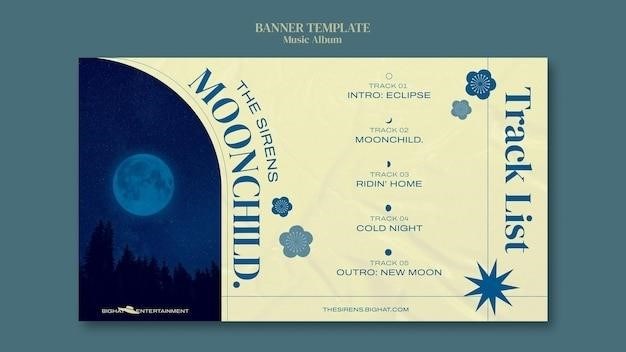A Midsummer Night’s Dream⁚ A Summary
A Midsummer Night’s Dream is a comedic play written by William Shakespeare in the late 16th century․ It follows the romantic entanglements of four young Athenian lovers⁚ Hermia, Lysander, Helena, and Demetrius, amidst the backdrop of the city’s ruling couple, Theseus and Hippolyta, as well as the whims of enchanted fairies․
The Setting and the Lovers
A Midsummer Night’s Dream unfolds in the vibrant city of Athens and the enchanted forest that surrounds it․ The play’s central conflict revolves around four young Athenian lovers⁚ Hermia, Lysander, Helena, and Demetrius․ Hermia finds herself caught between two suitors⁚ Lysander, whom she loves, and Demetrius, whom her father, Egeus, has chosen for her․ Hermia’s defiance of her father’s wishes and her pursuit of true love set the stage for a whirlwind of romantic misadventures․
The forest, a magical realm where fairies dwell, becomes the backdrop for the lovers’ escapades․ Under the spell of the mischievous Puck, the boundaries of love and reason blur, leading to a series of comical misunderstandings and passionate encounters․ As the lovers wander through the forest, their hearts are entangled in a web of desire and confusion, creating a tapestry of love and chaos that defines the play’s central conflict․
The Duke and the Queen
The play’s setting is also influenced by the presence of Theseus, the Duke of Athens, and his soon-to-be bride, Hippolyta, the Queen of the Amazons․ Theseus, a powerful ruler known for his wisdom and justice, is preparing for his grand wedding celebration․ This event provides a backdrop for the play’s unfolding chaos, as the lovers’ romantic entanglements intersect with the Duke’s courtly festivities․
The relationship between Theseus and Hippolyta reflects a more mature and settled form of love, contrasting with the youthful, tumultuous passions of the younger lovers․ Their presence adds an element of formality and power to the play, while their upcoming wedding serves as a reminder of the societal norms and expectations that shape the characters’ actions and choices․
The Fairy World
A Midsummer Night’s Dream features a magical realm inhabited by fairies, led by Oberon, the King of the fairies, and his mischievous attendant, Puck․ This world is full of enchantment and whimsy, where the laws of nature are often suspended․ Oberon and Titania, the Queen of the fairies, are engaged in a bitter feud, fueled by jealousy and a stolen Indian boy․ This conflict sets in motion the play’s magical events, as Oberon seeks to manipulate the lovers with a love potion made from a magical flower․
The fairies’ presence adds a layer of fantasy and wonder to the play, blurring the lines between reality and dream․ Their interventions in the human world create confusion and chaos, but ultimately lead to a resolution of the lovers’ conflicts․ The fairy world serves as a reminder that even in the midst of human drama, there are forces beyond our control that can shape our destinies․
The Play Within a Play
A Midsummer Night’s Dream includes a hilarious play-within-a-play, titled “Pyramus and Thisbe,” performed by a group of amateur actors from Athens․ These actors, known as the “mechanical”s, are a comical bunch, including Bottom, a weaver who dreams of playing all the roles, and Flute, a bellows-mender who is cast as Thisbe․ Their performance is riddled with mistakes, mispronunciations, and absurd interpretations․ The play is a parody of tragic love stories, with elements of slapstick comedy and a commentary on the nature of theater itself․
The play-within-a-play serves as a comedic counterpoint to the more serious themes of love and magic in the main plot․ It also acts as a reminder of the power of imagination and the importance of finding humor in life’s absurdities․ The actors’ clumsiness and comical mishaps highlight the contrast between the world of fairies and the human world, reminding us that both worlds have their own unique charms and complexities․
The Magic of the Forest
The forest surrounding Athens in A Midsummer Night’s Dream is a place of enchantment and wonder, where the boundaries between reality and fantasy blur․ It is ruled by the fairy king Oberon and queen Titania, who are engaged in a bitter feud․ Their rivalry spills over into the human world, as Oberon uses the magic of a love potion to manipulate the romantic entanglements of the four young Athenian lovers․ The forest becomes a stage for magical pranks and transformations, with Puck, Oberon’s mischievous jester, playing a key role in orchestrating the chaos․
The forest is a powerful symbol of the transformative power of love and the unpredictable nature of fate․ It is a place where dreams can come true, where identities can be shifted, and where the impossible becomes possible․ The magic of the forest is both exhilarating and unsettling, reminding us of the hidden forces that govern our lives and the potential for unexpected twists and turns in the human experience․
The Confusion of Love
The heart of A Midsummer Night’s Dream lies in the chaotic and comedic confusion of love․ The four young Athenians, Hermia, Lysander, Helena, and Demetrius, find themselves entangled in a web of unrequited affections and mistaken identities․ Hermia, for instance, is torn between her love for Lysander and her father’s demand that she marry Demetrius․ Meanwhile, Helena is hopelessly in love with Demetrius, who is oblivious to her feelings․ The love potion administered by Oberon further complicates matters, leading to a whirlwind of romantic mishaps and misunderstandings․
Shakespeare masterfully portrays the absurdity and capricious nature of love, highlighting its ability to both inspire and torment․ The lovers’ frantic pursuit of their desired partners, their jealous accusations, and their desperate attempts to make sense of their tangled emotions create a hilarious and poignant exploration of the complexities of human relationships․
The Resolution of the Conflicts
The resolution of the conflicts in A Midsummer Night’s Dream is a testament to the power of reconciliation and the transformative nature of love․ The fairy magic that has fueled the chaos is ultimately undone, with Puck restoring the lovers to their rightful partners․ Hermia and Lysander, Helena and Demetrius, finally find themselves united in their affections, their initial confusion and misunderstandings fading into the background․ The play’s resolution is not merely a happy ending; it is a celebration of the resilience of human relationships and the possibility of finding harmony amidst confusion․
The play’s conclusion underscores the theme of dreams and illusion, emphasizing that even in the face of chaos, love ultimately prevails․ The lovers, having experienced the absurdity of their own infatuations, emerge with a newfound understanding of themselves and their desires․ The play’s resolution suggests that love, despite its complexities, can ultimately bring order and happiness to the human experience․
The Themes of the Play
A Midsummer Night’s Dream explores a tapestry of themes, weaving together elements of love, illusion, and the nature of reality․ Love, in its various forms, is a central theme, from the passionate but tumultuous love of the young Athenians to the more mature and established love of Theseus and Hippolyta․ The play explores the capricious nature of love, its ability to both inspire and bewilder, and the transformative power it holds․ The play also delves into the themes of illusion and dreams, highlighting the blurring of boundaries between reality and imagination․
The magic of the forest, with its mischievous fairies and potent love potions, creates a world where appearances are deceiving and perceptions are easily manipulated․ The play ultimately suggests that reality is subjective, shaped by our individual perceptions and influenced by the forces that surround us․ The characters’ experiences in the forest challenge their understanding of the world and force them to confront the illusory nature of their desires․
The Importance of Dreams
Dreams play a crucial role in A Midsummer Night’s Dream, serving as a recurring motif that underscores the play’s exploration of illusion and the blurring of reality․ The play’s title itself hints at the significance of dreams, suggesting that the events unfolding are both whimsical and ephemeral, like the fleeting nature of dreams․ The characters’ experiences in the forest are often described as dreamlike, with magic and enchantment transforming their perceptions and creating a world where anything seems possible․
The play’s exploration of dreams goes beyond mere fantasy, delving into the psychological and philosophical implications of the human experience․ Dreams represent a realm of subconscious desires, hidden emotions, and unfulfilled longings․ The characters’ actions and interactions are often driven by their innermost desires, which are manifested in the dreamlike world of the forest․ The play suggests that dreams can both reveal and shape our reality, offering a glimpse into the complexities of our inner lives․

The Power of Love
Love is a central theme in A Midsummer Night’s Dream, explored in all its complexities and contradictions․ The play showcases the transformative power of love, its ability to inspire both joy and madness, and its capacity to drive characters to extreme measures․ The four young Athenian lovers – Hermia, Lysander, Helena, and Demetrius – find themselves caught in a whirlwind of passionate pursuit and rejection, highlighting the chaotic nature of romantic desire․
Shakespeare portrays love as a force that can defy logic and reason, leading characters to make impulsive decisions and act out of character․ The love potion administered by the mischievous Puck further emphasizes the irrationality of love, causing the lovers to experience sudden shifts in affection and become entangled in a web of confusion and frustration․ Ultimately, A Midsummer Night’s Dream suggests that love is a powerful force that can shape our destinies, even when it seems to lead us astray․
The Nature of Reality
A Midsummer Night’s Dream blurs the lines between reality and illusion, inviting the audience to question the nature of perception and experience․ The play’s setting in a magical forest, where fairies and mischievous sprites roam, creates an atmosphere of enchantment and unreality․ The characters’ encounters with magic and the supernatural, particularly the love potion’s effects, lead to a constant questioning of what is real and what is imagined․
The play also incorporates the theme of dreams, further blurring the boundaries of reality․ The characters’ experiences in the forest are often described as dreams or visions, highlighting the subjective nature of perception․ This blurring of reality is reinforced by the play within a play, “Pyramus and Thisbe,” which serves as a meta-theatrical commentary on the nature of performance and illusion․ Ultimately, A Midsummer Night’s Dream suggests that reality is fluid and malleable, shaped by our perceptions and the power of imagination․
Shakespeare’s Legacy
A Midsummer Night’s Dream, with its blend of romantic comedy, magical realism, and playful satire, has left an enduring legacy on theater and literature․ Shakespeare’s masterful use of language, his creation of memorable characters, and his exploration of universal themes continue to resonate with audiences centuries later․ The play’s enduring popularity is evident in its countless adaptations, reinterpretations, and references in popular culture․
Its themes of love, illusion, and the nature of reality continue to be relevant and engaging, sparking conversations about human nature and the complexities of relationships․ A Midsummer Night’s Dream is a testament to Shakespeare’s genius, a timeless masterpiece that continues to enchant and inspire audiences with its blend of humor, romance, and magical wonder․
